WASHINGTON, Oct. 29, 2010 — A panel of experts last night noted significant progress in the efforts of the Defense and Veterans Affairs departments to help servicemembers, veterans and their families affected by post-traumatic stress disorder.
At a special screening of the HBO documentary “War Torn, 1861–2010” at the Pentagon Auditorium, Army Chief of Staff Gen. George W. Casey noted that the percentage of servicemembers who avoid seeking psychological treatment because of a perceived stigma attached to asking for help has dropped from 90 percent to 50 percent.
Casey’s frequent assertion that building servicemembers’ emotional resilience is just as important as their physical conditioning – known in the Army as comprehensive soldier fitness — captured the essence of a panel discussion by medical and military experts following the documentary screening.
Panelists who took the stage to discuss how to treat PTSD were Gen. Peter W. Chiarelli, Army vice chief of staff; Dr. Katie Chard, director of the PTSD and anxiety disorders clinic at Cincinnati Veterans Medical Center; Gregory T. Goldstein, program manager for Marine Corps combat and operational stress control; Vietnam veteran and Medal of Honor recipient Capt. Paul W. “Buddy” Bucha; and retired Air Force Lt. Col. Greg Harbin, a victim of PTSD. Doug Wilson, assistant secretary of Defense for public affairs, and Tammy Duckworth, assistant secretary of veterans affairs for public and intergovernmental affairs, served as moderators.
“The Army and rest of Department of Defense are committed to finding ways to help [those with PTSD],” Chiarelli said, noting that more than 900,000 people have used the program’s global assessment tool that measures resilience.
“We can teach people to be more resilient,” he added.
Harbin said the documentary — which chronicles the effect of combat stress and post-traumatic stress on servicemembers and their families from the Civil War to the current conflicts in Iraq and Afghanistan — provides “a lot of hope.”
“We’re addressing a difficult problem,” he said, “and we’re taking the lead on it.” He spoke of his own struggle with PTSD. “One day, I called the Wounded Warrior Program, and it saved me. You people are the heroes,” he told the panel.
Chard said evidence-based treatment works for veterans and active-duty troops. The VA system has 3,000 PTSD-trained therapists, and DOD has 500, she said, so servicemembers can start therapy while still active duty, and then continue that therapy at a VA hospital after they leave the service. Chard said 150 hospitals around the United States have clinics with trained PTSD therapists.
Bucha said it took him 40 years to come to grips with his PTSD.
“I think for the first time, we’re having open, solid, honest effort, but we won’t be successful, as [Casey] said, if we’re only at 50 percent,” Bucha said. “It’s 100 percent [that we need]. You can have four stars or no stripes, man or woman, [and] you don’t know when it’s going to manifest itself, but it will. No one is exempt.”
More progress is needed in removing the stigma attached to seeking treatment, Bucha added. “It will start to go away when the three-stars and the four-stars and the tough sergeants major stand up to it,” he said, emphasizing that mental conditioning for the armed forces is vital.
Chiarelli said officials are working hard to get people the treatment they need as soon as possible, noting that the average time from the stress-inducing event to the start of therapy is 12 years.
“We’re training our medics to recognize symptoms downrange so we can start treating them immediately,” he said.
Goldstein said 1,400 Marines have been trained as mentors and to recognize the symptoms.
“So we’ve created the educated Marine who knows the behavior of other Marines, and is trained to intervene at the slightest behavioral change,” he said. “We can then turn to corpsmen, medical officers and the medical health team.
“It’s embedding into regiment level in Afghanistan,” he continued. “At the regiment level, when we intervene at the earliest moment, we don’t get to the tragedies we saw on this film tonight.”
He referred to an acronym, SMITR, for the treatment plan for PTSD: strengthen, mitigate, identify, treat and reintegrate.
Family members are an integral part of the equation when a servicemember suffers from PTSD, he said.
Chard added that it’s important for family members to go to family readiness meetings to find out what deployment is going to be like and to stay in contact with other families. “The VA is there for you before the veteran returns,” she said. “We can treat the vet with family counseling.” A hotline, 1–800-273-TALK, is not just for suicide prevention, Chard said.
“It’s for any difficulties you want to talk about,” she explained. “It’s open to all active duty members, reservists, veterans, Guard members and their families.”
Chard said that if someone exhibits PTSD symptoms, it’s important to recommend that they seek help. People can visit www.ncptsd.gov to find out how to recognize those symptoms, she added.
“I think everyone in this room had a deeply personal reaction to this documentary,” said Duckworth, a former Army helicopter pilot who lost both legs in Iraq in 2004. She referenced a soldier-artist in the film who drew pictures of injured servicemembers in Vietnam.
“I am one of those troops,” she said. “I survived because the troops in my National Guard unit saved me, Walter Reed [Army Medical Center] saved me, my peers saved me, and I’ve been given everything I need to survive, to thrive, to have the amazing job I have. VA and DOD want that for all of us.
“We can do better,” she added, “for each and every one of our veterans.”
Source:
U.S. Department of Defense
Office of the Assistant Secretary of Defense (Public Affairs)

 von
von 